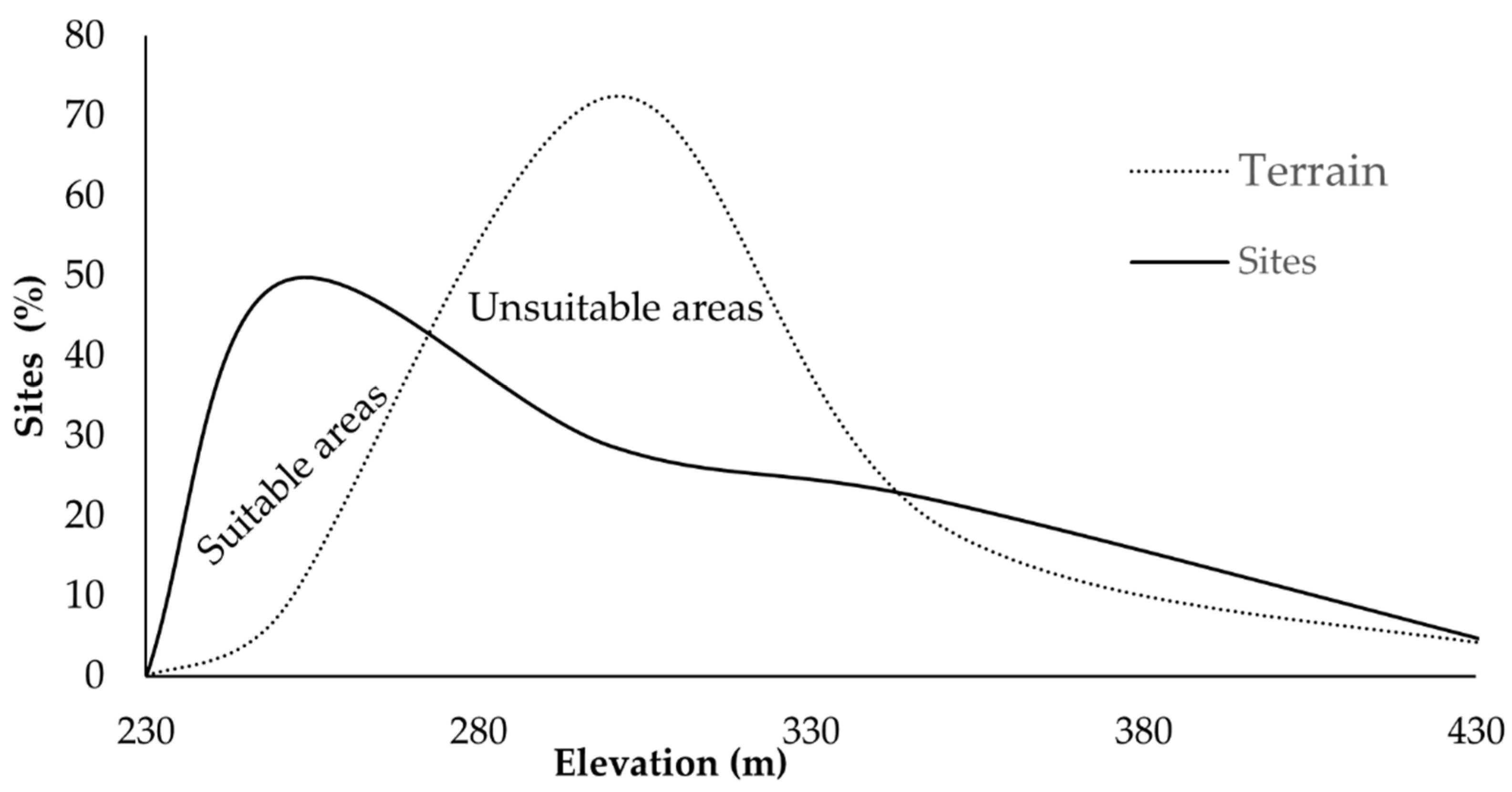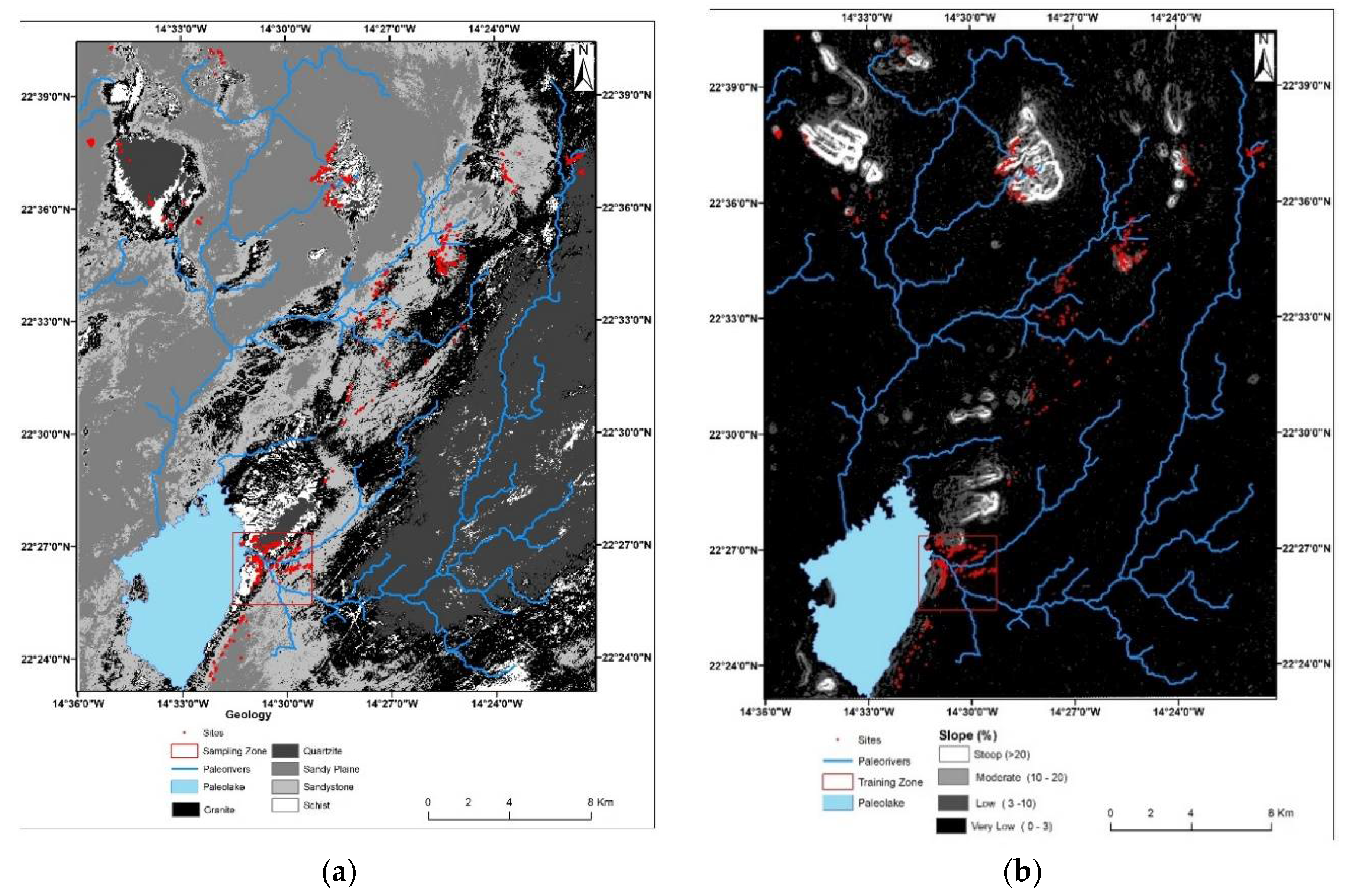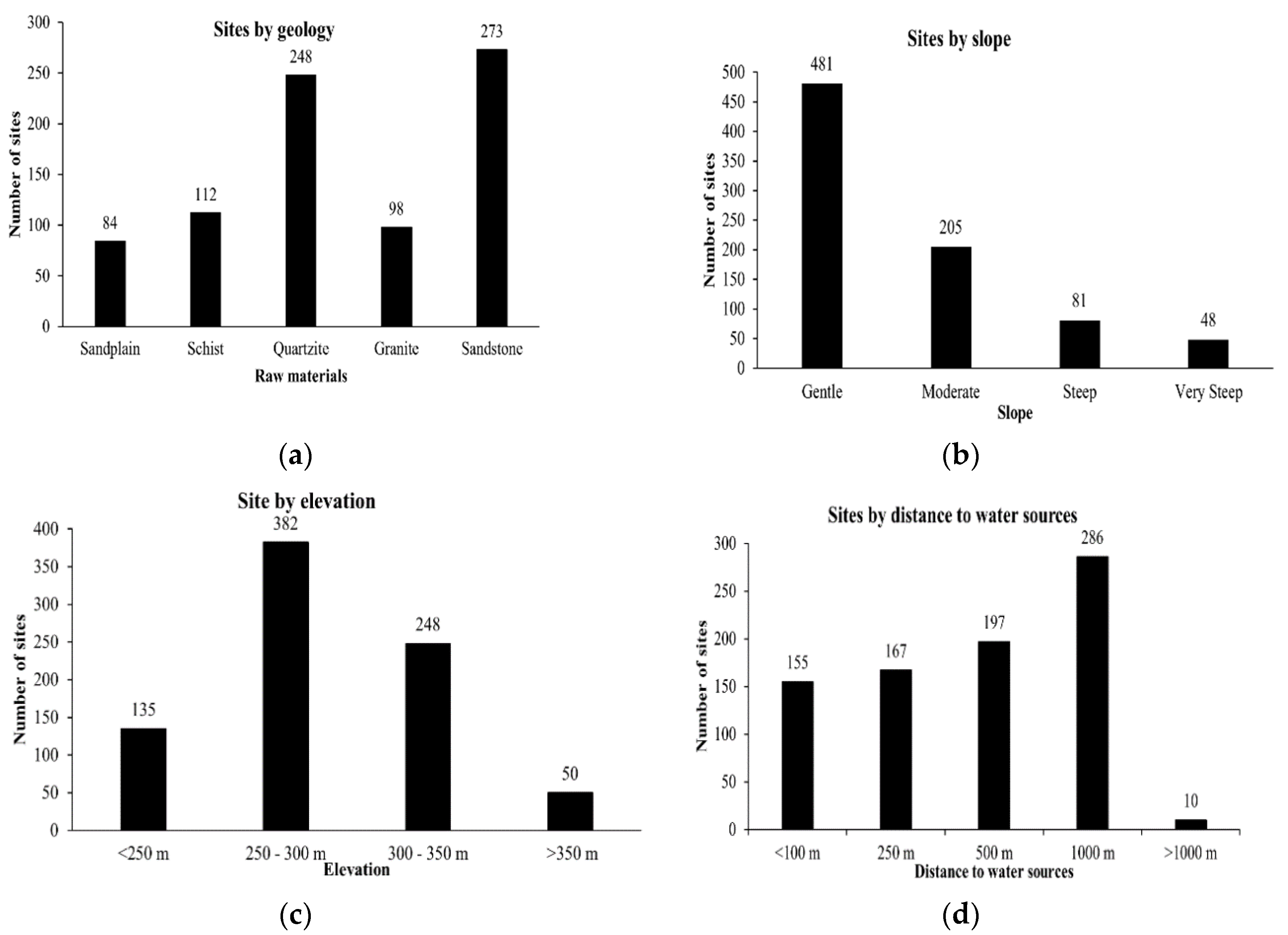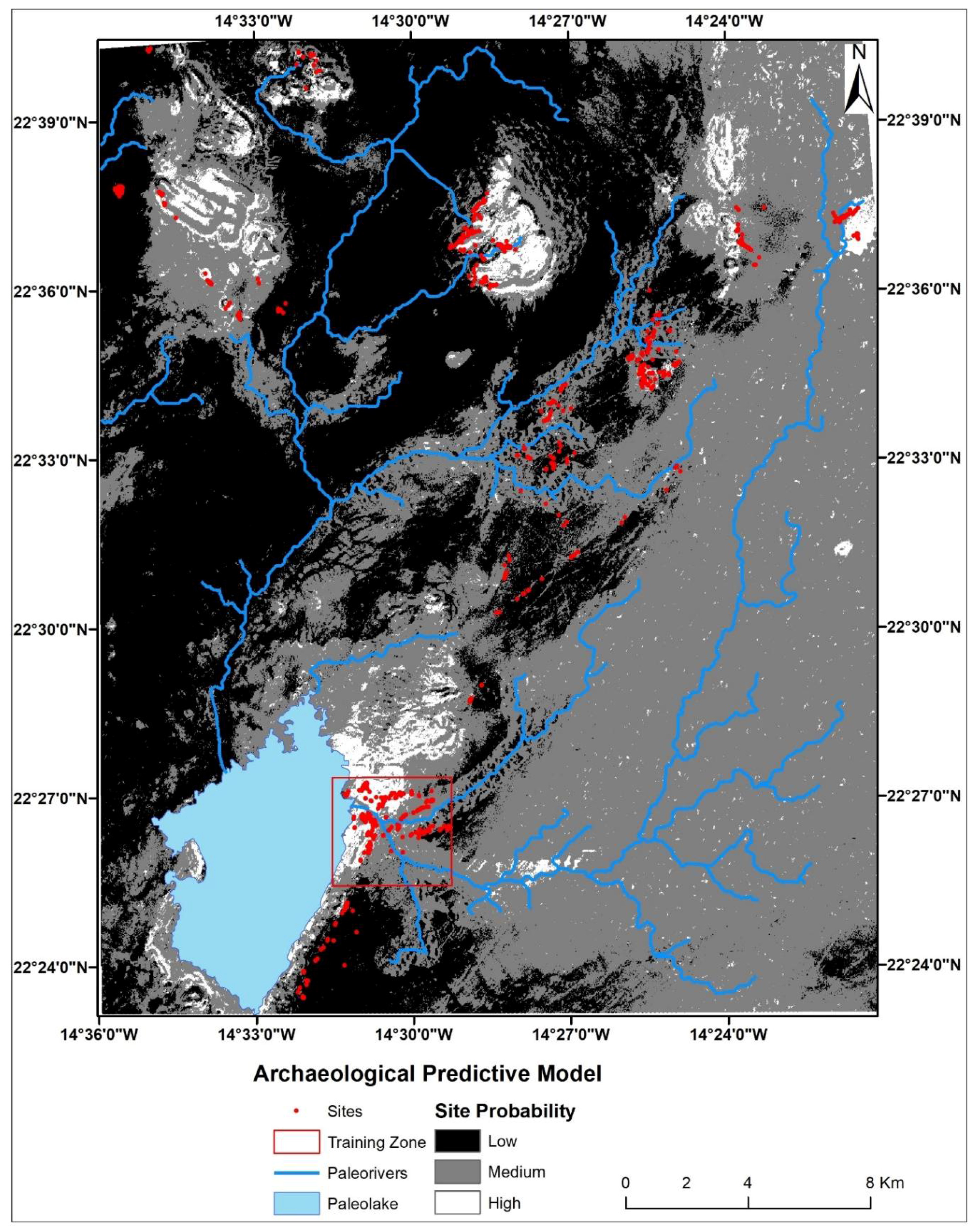GIS and Remote-Sensing Application in Archaeological Site Mapping in the Awsard Area (Morocco)
Abstract
:1. Introduction
2. Materials and Methods
2.1. Study Area
2.2. Data
2.2.1. Geo-Archaeological Database
2.2.2. Digital Elevation Model
- A SRTM DEM 1° arc-second image with a 30 m spatial resolution was downloaded from the United States Geological Survey (USGS) website http://earthexplorer.usgs.gov/
- An ASTER GDEM V2 images was downloaded from ASTER (Advanced Space-borne Thermal Emission and Reflection Radiometer) global DEM website http://www.jspacesystems.or.jp/ersdac/GDEM/E/4.html
- A DEM of the study area with 10 m cell size was generated through the digitization of contours and elevation points of a 1:50,000 scale topographic map.
2.2.3. Landsat ETM+ Multi-Spectral Image
2.3. Methodology
2.3.1. DEM Quality Assessment
2.3.2. Geo-Archaeological Variables
Slope
Geology and Lithology
- the alluvial cones
- the pediments;
- the plains and river terraces;
- the cuesta cuff trays;
- the benches of the slopes of the valleys and below;
- the dykes through the vast flat surface;
- the precambrian plan crystalline basement.
Aspect
Topography (Altitude)
Distance to Water Source
2.3.3. Dependency between Variables and Sites
- Null hypothesis (H0): that the sites are distributed irrespective of a given geo-environmental variable.
- Alternative hypothesis (H1): that the sites are distributed respective of a given geo-environmental variable.
2.3.4. Calculation of Class Coefficient and Weighting Variables
2.3.5. Principal Component Analysis
2.3.6. Analytic Hierarchy Process
3. Results and Discussion
4. Conclusions
Author Contributions
Funding
Acknowledgments
Conflicts of Interest
References
- Souville, G. Les principaux types des tumuli marocains. Bulletin de la Société Préhistorique de France 1959, 56, 394–402. [Google Scholar] [CrossRef]
- Nami, M. L’épopée de la pierre à travers les temps préhistoriques, La pierre et son usage à travers les âges: Jardins des Hespérides. Bulletin Semestriel de La Société Marocaine d’Archéologie et du Patrimoine 2008, 4, 18–24. [Google Scholar]
- Nami, M.; Moser, J.; Mikdad, A.; Eiwanger, J. Quelques aspects de l’Iberomaurisien du Rif Oriental (Maroc). Bulletin d’Archéologie Marocaine 2012, 4, 16–33. [Google Scholar]
- Bokbot, Y. Neolothique et protohistoire du Maroc. In Proceedings of the Actes du IIIème Colloque International sur l’Histoire et l’Archéologie de l’Afrique du Nord, Tabarka, Tunisie, 8–13 May 2000; Edition de l’Institut National du Patrimoine: Tunis, Tunisia, 2000; pp. 35–45. [Google Scholar]
- Haidar-Boustani, M.; Iban, J.J.; Al-Maqdissi, M.; Armendari, A.; Gonzalez Urquijo, J.; Teira, L. Prospections Archaeologiques a l’ouest de la ville de homs: Rapport preliminaire campagne 2004. Annales D’Histoire et D’Archaeologie 2004, 16–17, 9–38. [Google Scholar]
- Rowlands, A.; Sarris, A. Detection of exposed and subsurface archaeological remains using multi-sensor remote sensing. J. Archaeol. Sci. 2007, 34, 795–803. [Google Scholar] [CrossRef]
- Siart, C.; Eitel, B.; Panagiotopoulos, D. Investigation of past archaeological landscapes using remote sensing. J. Archaeol. Sci. 2008, 35, 2918–2926. [Google Scholar] [CrossRef]
- Kamermans, H. Smashing the crystal ball. A critical evaluation of the Dutch national archaeological predictive model (IKAW). Int. J. Hum. Arts Comput. 2007, 1, 71–84. [Google Scholar] [CrossRef]
- McCauley, J.F.; Schaber, G.G.; Breed, C.S.; Grolier, M.J.; Haynes, C.V.; Issawi, B.; Elachi, C.; Blom, R. Subsurface valleys and geoarchaeology of the eastern Sahara revealed by shuttle radar. Science 1982, 281, 1004–1020. [Google Scholar] [CrossRef] [PubMed]
- Bewley, R.; Donoghue, D.; Gaffney, V.; Van Leusen, M.; Wise, A. Archiving Aerial Photography and Remote Sensing Data: A Guide to Good Practice; Archaeology Data Service; Oxbow Books: Oxford, UK, 1999. [Google Scholar]
- Wynn, J.C. Applications of high-resolution geophysical methods to archaeology. In Archaeological Geology of North America Centennial Special Volume; Lasca, N.P., Donahue, J., Eds.; Geological Society of America: Boulder, CO, USA, 1990; pp. 603–617. [Google Scholar]
- Theocaris, P.S.; Liritzis, I.; Lagios, E.; Sampson, A. Geophysical prospection, archaeological excavation, and dating in two Hellenic pyramids. Surv. Geophys. 1996, 17, 593–618. [Google Scholar] [CrossRef]
- Gaffney, C.; Gaffney, V. Non-invasive investigations at Wroxeter at the end of the twentieth century. J. Archaeol. Prospect. 2000, 7, 65–67. [Google Scholar] [CrossRef]
- Jones, R.E.; Sarris, A.J. Geophysical and related techniques applied to archaeological survey in the Mediterranean: A review. J. Mediterr. Archaeol. 2000, 13, 3–75. [Google Scholar]
- Neubauer, W. Images of the invisible-prospection methods for the documentation of threatened archaeological sites. Naturwissenschaften 2001, 88, 13–24. [Google Scholar] [CrossRef] [PubMed]
- Kvamme, K.L. Geophysical surveys as landscape archaeology. Am. Antiq. 2003, 68, 435–457. [Google Scholar] [CrossRef]
- Montufo, A.M. The use of satellite imagery and digital image processing in landscape archaeology: A case study from the island of Mallorca, Spain. Geoarchaeology 1997, 2, 71–85. [Google Scholar] [CrossRef]
- Powlesland, D.; Lyall, J.; Donoghue, D. Enhancing the record through remote sensing: The application and integration of multi-sensor, non-invasive remote sensing techniques for the enhancement of the Sites and Monuments Record. Heslerton Parish Project, N. Yorkshire, England. Internet Archaeol. 1997, 2. [Google Scholar] [CrossRef]
- Fowler, M.J.F. Satellite remote sensing and archaeology: A comparative study of satellite imagery of the environs of Figsbury Ring, Wiltshire. J. Archaeol. Prospect. 2002, 9, 55–69. [Google Scholar] [CrossRef]
- Banes, I. Aerial remote-sensing techniques used in the management of archaeological monuments on the British Army’s Salisbury Plain Training Area Wiltshire, UK. J. Archaeol. Prospect. 2003, 10, 83–90. [Google Scholar] [CrossRef]
- Devereux, B.J.; Amable, G.S.; Crow, P.; Cliff, A.D. The potential of airborne lidar for detection of archaeological features under woodland canopies. Antiquity 2005, 79, 648–660. [Google Scholar] [CrossRef]
- Challis, K. Airborne laser altimetry in alluviated landscapes. J. Archaeol. Prospect. 2006, 13, 103–127. [Google Scholar] [CrossRef]
- Lasaponara, R.; Masini, N. Satellite Remote Sensing: A New Tool for Archaeology; Springer Science & Business Media: Cham, The Netherlands, 2012. [Google Scholar]
- Chen, R.; Lasaponar, R.; Masini, N. An overview of satellite synthetic aperture radar remote sensing in archaeology: From site detection to monitoring. J. Cult. Herit. 2015, 23, 5–11. [Google Scholar] [CrossRef]
- Tapete, D.; Cigna, F. Trends and perspectives of space-borne SAR remote sensing for archaeological landscape and cultural heritage applications. J. Archaeol. Sci. Rep. 2017, 14, 716–726. [Google Scholar] [CrossRef] [Green Version]
- Van der Meer, F.D.; De Jong, S.M. Introduction. In Imaging Spectrometry: Basic Principles and Prospective Applications; Van der Meer, F.D., de Jong, S.M., Eds.; Kluwer Academic Publishers: Dordrecht, The Netherlands, 2001; pp. XXI–XXIII. [Google Scholar]
- Kumar, L.; Schmidt, K.; Dury, S.; Skidmore, A. Imaging spectrometry and vegetation science. In Imaging Spectrometry: Basic Principles and Prospective Applications; Van der Meer, F.D., de Jong, S.M., Eds.; Kluwer Academic Publishers: Dordrecht, The Netherlands, 2001; pp. 111–155. [Google Scholar]
- Lucas, R.M.; Rowlands, A.P.; Niemann, O.; Merton, R. Hyperspectral sensors: Past, present and future. In Advanced Image Processing Techniques for Remotely Sensed Hyperspectral Data; Varshney, P.K., Arora, M.K., Eds.; Springer: Berlin/Heidelberg, Germany, 2004; pp. 11–40. [Google Scholar]
- Huggett, J. Looking at intra-site GIS. In CAA96 Computer Applications and Quantitative Methods in Archaeology; Lockyear, K., Sly, T.J.T., Mihailescu-Birliba, V., Eds.; BAR International Series 845; Archaeopress: Oxford, UK, 2000; pp. 117–122. [Google Scholar]
- Vullo, N.; Fontana, F.; Guerreschi, A. The application of GIS to intra-site spatial analysis: Preliminary results from Alpe Veglia (VB) and Mondeval de Sora (BL), two Mesolithic sites in the Italian Alps. In New Techniques for Old Times: CAA98; Barcelo, J.A., Briz, I., Vila, A., Eds.; British Archaeological Reports International Series 757; Archaeopress: Oxford, UK, 1999; pp. 111–116. [Google Scholar]
- Robinson, J.; Zubrow, E. Between space space: Interpolation in Archaeology. In Geographical Information Systems and Landscaoe Archaeology; Gillings, M., Mattingly, D., Dalem, J.V., Eds.; Oxbow Books: Oxford, UK, 1999; pp. 65–84. [Google Scholar]
- Wheatley, D.; Gillings, M. Spatial technology and archaeology. In The Archaeological Applications of GIS 2002; Taylor and Francis: London, UK, 2002. [Google Scholar] [CrossRef]
- Verhagen, P. Case studies in Archaeological Predictive Modelling; Archaeological Studies Leiden University; Leiden University Press: Leiden, The Netherlands, 2007. [Google Scholar]
- Wheatley, D. Cumulative viewshed analysis: A GIS-based method for investigating intervisibility, and its archaeological applications. In Archaeology and Geographical Information Systems: A European Perspective; Lock, G., Stančič, Z., Eds.; Taylor & Francis: London, UK, 1995; pp. 171–185. [Google Scholar]
- Wheatley, D. The use of GIS to understand regional variation in Neolithic Wessex. In New Methods, Old Problems: Geographic Information Systems in Modern Archaeological Research; Maschner, H.D.G., Ed.; Occasional Paper No. 23; Center for Archaeological Investigations, Southern Illinois University: Carbondale, IL, USA, 1996; pp. 75–103. [Google Scholar]
- Wheatley, D. Making space for an archaeology of place. Internet Archaeol. 2004, 15. [Google Scholar] [CrossRef]
- Roeloffs, A.; Wiatr, T.; Reicherter, K.; Museum, S.N. Prospection of Karstic Caves Using Gis and Remote Sensing. In Proceedings of the ISPRS WG VII/5 Workshop, Cologne, Germany, 18–19 November 2011; pp. 107–115. [Google Scholar]
- Belmonte, J.; Esteban, C.; Cuesta, L.; Perera Betancort, M.; Gonzarez, J. Pre-Islamic burial moniments in Northern and Saharn Morocco. Archaeoastronomy 1999, 30, 21. [Google Scholar] [CrossRef]
- Linstädter, J.; Blatt, M. Sea, slopes and shelters: Archaeological Surveys along the Mediterranean Coast, west of the Melilla Peninsula (Morocco). In Pleistocene Foragers: Their Culture and Environment; Pastoors, A., Aufferman, B., Eds.; Wissenschaftliche Schriften des Nneanderthal Museums: Mettmann, Germany, 2013; pp. 27–32. [Google Scholar]
- Di Lernia, S. Places, monuments, and landscape: Evidence from the Holocene central Sahara, Azania. Archaeol. Res. Afr. 2013, 48, 173–192. [Google Scholar] [CrossRef]
- Galan, E.; Torres, J.; Senoran, J.M. Archaeological Interventions. In Search of Traces of the Human Presence in the Valley. Complutum 2014, 25, 45–76. [Google Scholar]
- Pappu, S.; Akhilesh, K.; Ravindranath, S.; Raj, U. Applications of satellite remote sensing for research and heritage management in Indian prehistory. J. Archaeol. Sci. 2010, 37, 2316–2331. [Google Scholar] [CrossRef]
- Brooks, N.; Clarke, J.; Garfi, S.; Pirie, A. The archaeology of Western Sahara: Results of environmental and archaeological reconnaissance. Antiquity 2009, 83, 918–934. [Google Scholar] [CrossRef]
- Kohler, T.A. Predictive locational modelling: History and current practice. In Quantifying the Present and Predicting the Past: Theory, Method and Application of Archaeological Predictive Modeling; Judge, W.L., Sebastian, L., Eds.; US Bureau of Land Management: Denver, CO, USA, 1988; pp. 19–59. [Google Scholar]
- Alexakis, D.; Sarris, A.; Astaras, T.; Albanakis, K. Integrated GIS, remote sensing and geomorphologic approaches for the reconstruction of the landscape habitation of Thessaly during the neolithic period. J. Archaeol. Sci. 2011, 38, 89–100. [Google Scholar] [CrossRef]
- Clement, O.C.; Sahadeb, D.; Kloot, R. Using GIS to Predict Likely Archaeological Sites. Available online: https://digitalcommons.du.edu/cgi/viewcontent.cgi?article=1056&context=geog_ms_capstone (accessed on 22 June 2017).
- Makepeace, G.A. The Prehistoric Archaeology of Settlement in South-East Wales and the Borders; Archaeopress: Oxford, UK, 2006; pp. 25–26. [Google Scholar]
- Van Leusen, M.; Deeben, J.; Hallewa, D.; Zoetbrood, P.; Kamerman, H.; Verhagen, P. Predictive Modelling for Archaeological Heritage Management: A Research Agenda; van Leusen, P.M., Kamermans, H., Eds.; Rijksdienst voor het Oudheidkundig Bodemonderzoek: Amersfoort, The Netherlands, 2004. [Google Scholar]
- Di Lernia, S. The archaeology of rock art in Northern Africa. In The Oxford Handbook of the Archaeology and Anthropology of Rock Art; David, B., McNiven, I., Eds.; Oxford University Press: Oxford, UK, 2017. [Google Scholar] [CrossRef]
- Canning, S. “BELIEF” in the past: Dempster-Shafer theory, GIS and archaeological predictive modelling. Aust. Archaeol. 2005, 60, 6–15. [Google Scholar] [CrossRef]
- Mink, P.B.; Ripy, J.; Bailey, K. Predictive archaeological modeling using gis-based fuzzy set estimation: A case study in Woodford County, Kentucky. In Proceedings of the 88th Annual Meeting on Transportation Research Board, Washington DC, USA, 11–15 January 2009. [Google Scholar]
- Crósta, A.P.; Moore, J.M. Geological mapping using Landsat Thematic Mapper imagery in Almeria Province, south-east Spain. Int. J. Remote Sens. 1989, 10, 505–514. [Google Scholar] [CrossRef]
- Congalton, R.G. A review of assessing the accuracy of classifications of remotely sensed data. Remote Sens. Environ. 1991, 37, 35–46. [Google Scholar] [CrossRef]
- Foody, G.M. Status of land cover classification accuracy assessment. Remote Sens. Environ. 2002, 80, 185–201. [Google Scholar] [CrossRef]
- Diggs, D.M.; Brunswig, R.H. Weights of Evidence Modeling in Archaeology in Rocky Mountain National Park. In Proceedings of the ESRI International User Conference, San Diego, CA, USA, 12–16 July 2010; Available online: http://www.unco.edu/geography/faculty/diggs/docs/diggs_brunswig_esri_2009b_ppoint2003.ppt (accessed on 21 July 2014).
- Yang, L.; Pei, A.; Guo, N.; Liang, B. Spatial Modality of Prehistoric Settlement Sites in Luoyang Area. Sci. Geogr. Sin. 2012, 32, 993–999. [Google Scholar]
- Kvamme, K.L. One-Sample Tests in Regional Archaeological Analysis: New Possibilities through Computer Technology. Am. Ant. 1990, 55, 367–381. [Google Scholar] [CrossRef]
- Eastman, J.R. IDRISI Kilimanjaro Guide to GIS and Image Processing; Clark Univesity: Worcester, MA, USA, 2003. [Google Scholar]
- Fattah, M.A. Multicollinearity. Central Michigan University, 2010. Available online: http://www.chsbs.cmich.edu/fattah/courses/empirical/multicollinearity.html (accessed on 15 May 2014).
- Esri. How Principal Component Analysis Works. Retrieved from ArcGIS Resource Center. Available online: http://help.arcgis.com/en/arcgisdesktop/10.0/help/index.html#/How_Principal_Co mponents_works/009z000000qm000000/ (accessed on 7 May 2014).
- Saaty, T.L. The Analytical Hierarchy Process; McGraw Hill: New York, NY, USA, 1980. [Google Scholar]
- Malczewski, J. GIS and Multicriteria Decision Analysis; John Wiley & Sons, Inc.: Toronto, ON, Canada, 1999. [Google Scholar]
- Chandio, I.A. GIS-basedland suitability analysis of sustainable hillside development. In Proceedings of the Fourth International Symposium on Infrastructure Engineering in Developing Countries, Karachi, Pakistan, 11–13 December 2013. [Google Scholar] [CrossRef]
- Park, S.; Jeon, S.; Kim, S.; Choi, C. Prediction and Comparaison of Urban Growth by Land Suitability Index Mapping Using GIS and RS in South Korea. Landsc. Urban Plan. 2011, 99, 104–114. [Google Scholar] [CrossRef]
- Mithen, S. The domestication of water: Water management in the ancient world and its prehistoricorigins in the jordan valley. Philos. Trans. R. Soc. Lond. A Math. Phys. Eng. Sci. 2010, 368, 5249–5274. [Google Scholar] [CrossRef] [PubMed]
- Joanne, C.; Brooks, N.; Banning, E.B.; Matthewsd, M.; Campbell, S.; Clare, L.; Cremaschi, M.; di Lernia, S.; Drake, N.; Gallinaro, M.; et al. Climatic changes and social transformations in the Near East and North Africa during the ‘long’ 4th millennium BC: A comparative study of environmental and archaeological evidence. Quat. Sci. Rev. 2016, 136, 96–121. [Google Scholar] [CrossRef] [Green Version]
- Kvamme, K.L. Development and testing of Quantitative models. In Quantifying the Present and Predicting the Past: Theory, Method and Application of Archaeological Predictive Modelling; Judge, W., Sebastian, L., Eds.; Bureau of Land Management: Denver, CO, USA, 1988; pp. 325–428. [Google Scholar]









| ER (m) | EDEM TOPO (m) | EDEM ASTER (m) | EDEM SRTM (m) | (ER − EDEM TOPO)2 (m) | (ER − EDEMA STER)2 (m) | (ER − EDEM SRTM)2 (m) |
|---|---|---|---|---|---|---|
| 338 | 329 | 333 | 330 | 81 | 25 | 64 |
| 346 | 343 | 368 | 321 | 9 | 484 | 625 |
| 286 | 280 | 275 | 277 | 36 | 121 | 81 |
| 283 | 268 | 273 | 253 | 225 | 100 | 900 |
| 277 | 279 | 284 | 276 | 4 | 49 | 1 |
| 276 | 272 | 261 | 271 | 16 | 225 | 25 |
| 289 | 291 | 274 | 277 | 4 | 225 | 144 |
| 302 | 318 | 290 | 293 | 256 | 144 | 81 |
| 334 | 356 | 337 | 334 | 484 | 9 | 0 |
| 283 | 274 | 272 | 272 | 81 | 121 | 121 |
| 119.6 | 150.3 | 204.2 | ||||
| 10.936 | 12.260 | 14.290 |
| Class | Expectations (Sampling Zone) | Observations (Sampling Zone) | Coefficient | D | ||||||
|---|---|---|---|---|---|---|---|---|---|---|
| Area km2 | Area % | Expected | Cumulative Frequency | Sites | % Sites | Cumulative Frequency | ||||
| Slope in % | 0–3 | 17.40 | 82.29 | 192 | 0.823 | 111 | 47.64 | 0.476 | 4 | 0.347 |
| 3–10 | 3.57 | 16.91 | 39 | 0.992 | 119 | 51.07 | 0.987 | 8 | 0.005 | |
| 10–20 | 0.17 | 0.80 | 2 | 1 | 3 | 1.29 | 1.000 | 6 | 0.000 | |
| >20 | 0.00 | 0.00 | 0 | 1 | 0 | 0.00 | 1 | 1 | 0.000 | |
| n = | 21.14 | 100 | 233 | 233 | 100 | Dmax = | 0.347 | |||
| Geological unit | Quartzite | 1.42 | 10.23 | 24 | 0.102 | 48 | 20.60 | 0.206 | 7 | 0.104 |
| Schist | 2.19 | 15.83 | 37 | 0.261 | 54 | 23.18 | 0.438 | 6 | 0.177 | |
| Granite | 2.84 | 20.49 | 48 | 0.466 | 57 | 24.46 | 0.682 | 5 | 0.217 | |
| Sandstone | 6.68 | 48.27 | 112 | 0.948 | 74 | 31.76 | 1.000 | 4 | 0.052 | |
| Sandy Plain | 0.72 | 5.18 | 12 | 1 | 0 | 0.00 | 1 | 1 | 0.000 | |
| n = | 13.84 | 100 | 233 | 233 | 100 | Dmax = | 0.217 | |||
| Dist. water (m) | <100 | 4.32 | 26.50 | 62 | 0.265 | 40 | 17.17 | 0.172 | 4 | 0.093 |
| 100–250 | 3.62 | 22.20 | 52 | 0.487 | 66 | 28.33 | 0.455 | 6 | 0.032 | |
| 250–500 | 4.30 | 26.38 | 61 | 0.751 | 68 | 29.18 | 0.747 | 5 | 0.004 | |
| 500–1000 | 3.53 | 21.68 | 51 | 0.968 | 54 | 23.18 | 0.979 | 5 | 0.011 | |
| >1000 | 0.53 | 3.24 | 7.56 | 1 | 5 | 2.15 | 1 | 4 | 0.000 | |
| n = | 16.29 | 100 | 233 | 233 | 100 | Dmax = | 0.093 | |||
| Elevation (m) | <250 | 1.62 | 7.66 | 17.85 | 0.08 | 116 | 49.79 | 0.498 | 9 | 0.421 |
| 250–300 | 15.30 | 72.37 | 168.62 | 0.80 | 66 | 28.33 | 0.781 | 3 | 0.019 | |
| 300–350 | 3.90 | 18.45 | 42.99 | 0.98 | 51 | 21.89 | 1.000 | 5 | 0.015 | |
| >350 | 0.32 | 1.52 | 3.54 | 1.00 | 0 | 0.00 | 1.0 | 0 | 0.000 | |
| n = | 21.14 | 100 | 233 | 233 | 100 | Dmax = | 0.421 | |||
| Aspect | North | 4.09 | 19.35 | 45.08 | 0.19 | 55 | 23.61 | 0.24 | 5 | 0.043 |
| East | 4.53 | 21.42 | 49.91 | 0.41 | 61 | 26.18 | 0.50 | 5 | 0.090 | |
| South | 4.91 | 23.24 | 54.15 | 0.64 | 53 | 22.75 | 0.73 | 5 | 0.085 | |
| West | 7.61 | 35.99 | 83.86 | 1.00 | 64 | 27.47 | 1.00 | 4 | 0.000 | |
| n = | 21.14 | 100 | 233 | 233 | 100 | Dmax = | 0.090 | |||
| 1/9 | 1/7 | 1/5 | 1/3 | 1 | 3 | 5 | 7 | 9 |
|---|---|---|---|---|---|---|---|---|
| Extremely | Very Strongly | Strongly | Moderately | Equally | Moderately | Strongly | Very Strongly | Extremely |
| Less important | Very important | |||||||
| Geology | Slope | Elevation | Distance Water | Aspect | |
|---|---|---|---|---|---|
| Geology | 1.000 | 1.500 | 2.000 | 6.000 | 6.000 |
| Slope | 0.667 | 1.000 | 1.330 | 4.000 | 4.000 |
| Elevation | 0.500 | 0.752 | 1.000 | 3.000 | 3.000 |
| Distance water | 0.167 | 0.250 | 0.333 | 1.000 | 1.000 |
| Aspect | 0.167 | 0.250 | 0.333 | 1.000 | 1.000 |
| Geology | Slope | Elevation | Distance Water | Aspect | Priority | |
|---|---|---|---|---|---|---|
| Geology | 0.400 | 0.400 | 0.400 | 0.400 | 0.400 | 0.400 |
| Slope | 0.267 | 0.267 | 0.266 | 0.267 | 0.267 | 0.267 |
| Elevation | 0.200 | 0.200 | 0.200 | 0.200 | 0.200 | 0.200 |
| Distance water | 0.067 | 0.067 | 0.067 | 0.067 | 0.067 | 0.067 |
| Aspect | 0.067 | 0.067 | 0.067 | 0.067 | 0.067 | 0.067 |
| Prediction | Area (%) | Sites (Number) | Sites (%) |
|---|---|---|---|
| Low | 40.50 | 56 | 9.62 |
| Medium | 55.46 | 195 | 33.50 |
| High | 4.04 | 331 | 56.87 |
© 2018 by the authors. Licensee MDPI, Basel, Switzerland. This article is an open access article distributed under the terms and conditions of the Creative Commons Attribution (CC BY) license (http://creativecommons.org/licenses/by/4.0/).
Share and Cite
Nsanziyera, A.F.; Rhinane, H.; Oujaa, A.; Mubea, K. GIS and Remote-Sensing Application in Archaeological Site Mapping in the Awsard Area (Morocco). Geosciences 2018, 8, 207. https://doi.org/10.3390/geosciences8060207
Nsanziyera AF, Rhinane H, Oujaa A, Mubea K. GIS and Remote-Sensing Application in Archaeological Site Mapping in the Awsard Area (Morocco). Geosciences. 2018; 8(6):207. https://doi.org/10.3390/geosciences8060207
Chicago/Turabian StyleNsanziyera, Ange Felix, Hassan Rhinane, Aicha Oujaa, and Kenneth Mubea. 2018. "GIS and Remote-Sensing Application in Archaeological Site Mapping in the Awsard Area (Morocco)" Geosciences 8, no. 6: 207. https://doi.org/10.3390/geosciences8060207





